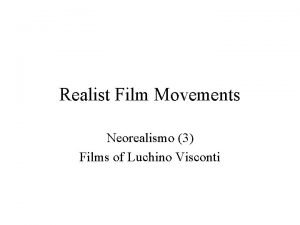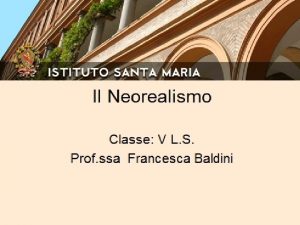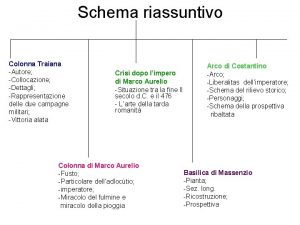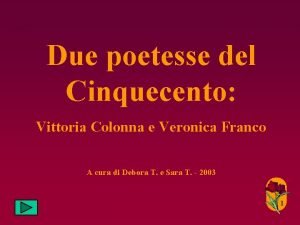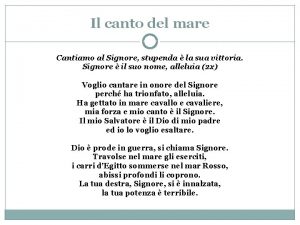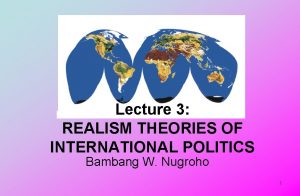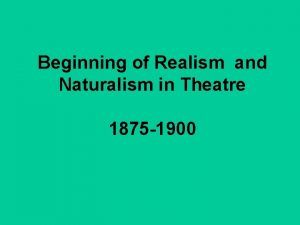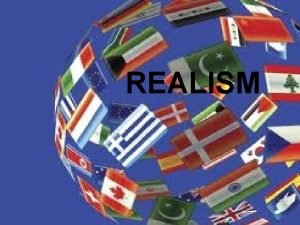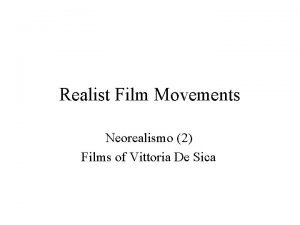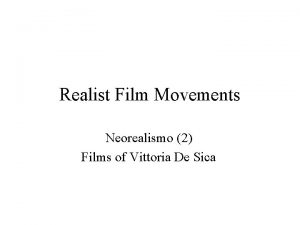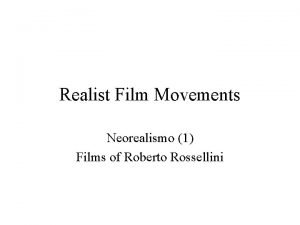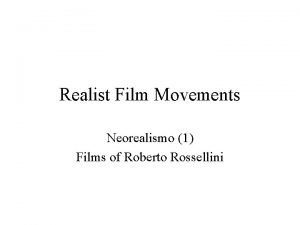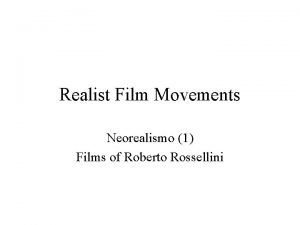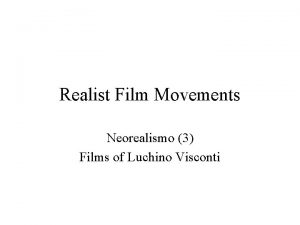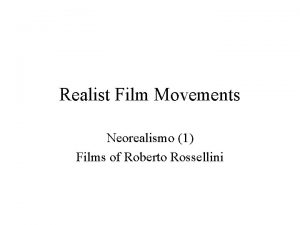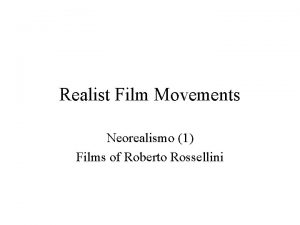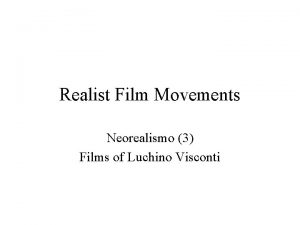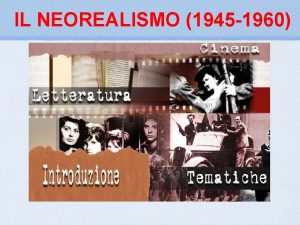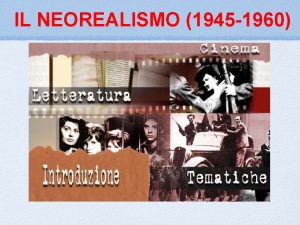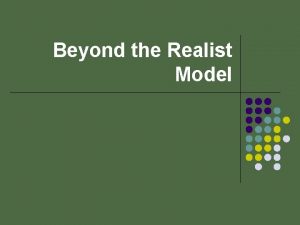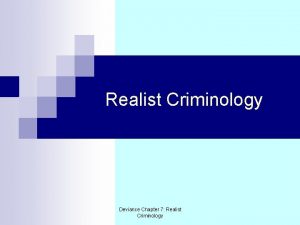Realist Film Movements Neorealismo 2 Films of Vittoria
























- Slides: 24

Realist Film Movements Neorealismo (2) Films of Vittoria De Sica

Table of Contents 1) Neorealismo as personal film 2) Films of Vittorio De Sica 3) Ladri di biciclette 4) Cesare Zavattini

Neorealismo as Personal Film • Traditional films - studio bound; genre bound; star bound • Films made according to the studio’s concerns and intentions; the requirements of a genre; and the demand of stars. • Personal films reflect film makers’ personal concerns. Neorealists’ PERSONAL CONCERNS and INTEREST are …

Neorealismo as Personal Film • Ordinary lives in the post-war era; • Social issues - unemployment, immigration, poverty, social and moral decay, political corruption • Lives of ordinary people in ordinary situation

Neorealismo as Personal Film • Influence of French lyrical (poetic) realism • Films in the 1930 s by Julian Duvivier, Jean Renoir, Marcel Carné and others • They did in cinema what some realist painters and writers had already done.

• Jean-Auguste. Dominique Ingres, The Valpinçon Bather (1808) • Academy Painting


• Jean-Louis David, Marat Assassinated (1793) • History Painting

• Jean-Paul Marat, a Swiss-born radical journalist. He was murdered in a bathtub by Charlotte Corday, a Girondin sympathizer, in 1793.

• Gustav Courbet, The Meeting, Bonjour Monsieur Courbet (1854) ‘Le Réalisme’

Neorealismo as Personal Film • What is realism in literature? '… more extensive and socially inferior human groups to the position of subject matter [in literature]. ' (Erich Auerbach, Mimesis: The Representation of Reality in Western Literature, p. 491)

Neorealismo as Personal Film • Jean Renoir, La Bete humaine (1938) • Based on Emile Zola’s naturalist novel, it is a story about an engineer who murders his wife’s godfather.

Neorealismo as Personal Film • Jean Renoir, Toni (1935) • Based on a police dossier, it is about a crime of passion. An Italian immigrant worker in a Provencal quarry is entangled in complicated love affairs and jealousy.

Neorealismo as Personal Film • Marcel Carne, Le Jour se leve (1939) • A foundry worker is forced to murder a man who betrays and trick him.

Neorealismo as Personal Film • Subject matters – ordinary people who are in ordinary situation but fail to gain ordinary happiness. • Stories of ordinary people in authentic settings • No idealization, no flattery, not larger-thanlife portraying

Films of Vittorio De Sica • Vittorio de Sica (19021974) • A matinee idol turned into a film director. • The collaboration with Cezare Zavattini lead to the three great neorealist films

Films of Vittorio De Sica • Sciusciá (Shoeshine, 1946) - two shoeshine boys save money by delivering black-market goods to buy a horse. They are caught and sent to overcrowded boys prison. One boy betrays the other and after their release the latter kills the former by mistake.

Films of Vittorio De Sica • Ladri di biciclette (Bicycle Thieves, 1948) - a man in Rome found a job after two years’ waiting on the condition that he has his own bike. It is stolen on the very first day in his job. He searches all over Rome with his son. In desperation he himself turns to a bicycle thief.

Films of Vittorio De Sica • Umberto D (1952) - a retired civil servant, pensioner, finds difficult to make end meet in ridiculous inflation. He is kicked out of his apartment and has to abandon his dog, his only possession and companion.

Films of Vittorio De Sica • Elements which made Ladri di biciclette a 'realist' film in its day ① the subject matter ② the narrative strays ③ the use of non-actors and location shooting ④ no facile solution to the problem illustrated ⑤ other aforementioned techniques

Films of Vittorio De Sica • Lamberto Maggiorani was a factory worker found by De Sica. • No solution to unemployment is presented - the ending is open-ended as our life is.

Ceare Zavattini • Screenwriter, director, painter, writer and theorist • Collaborated with Vittorio De Sica in Sciuscia, Ladri di biciclette and Umberto D • Teacher at Centro Sperimentale di Cinema • Critic at Bianco e nero PURIST

Ceare Zavattini • ‘A well-know American producer told me, “This is how we would imagine a scene with an airplane. The plane passes by … a machine gun fires … the plane is crashed. And this is how you would imagine it. The plane passes by … the plane passes by once more. ”’ • Cezare Zavattini, ‘Some Ideas on Cinema’

Cesare Zavattini • 'The dream of Zavattini is just to make a ninety-minute film of the life of a man to whom nothing ever happens. ' (Andre Bazin on Cesare Zavattini) • The duration of actual time is equal to that of film’s narrative time. • ‘Little-man' principle’ - 'a hole in the wall of a family house in order to peep inside. '
 Who owns working title
Who owns working title Luchino visconti neorealismo
Luchino visconti neorealismo Neorealismo e verismo
Neorealismo e verismo Which of the following is also known as axial movement
Which of the following is also known as axial movement French film movements
French film movements Maria vittoria cannatelli
Maria vittoria cannatelli Boccia vittoria unior
Boccia vittoria unior Colonna traiana collocazione
Colonna traiana collocazione Vittoria colonna biografia
Vittoria colonna biografia Iiss vittoria colonna
Iiss vittoria colonna Cause della prima guerra punica
Cause della prima guerra punica Vittoria petrillo
Vittoria petrillo Cantate al signore stupenda è la sua vittoria
Cantate al signore stupenda è la sua vittoria Lingua e cultura italiana per stranieri unior
Lingua e cultura italiana per stranieri unior Slipper or guide bearing
Slipper or guide bearing October 18 1977
October 18 1977 Realist thinking style
Realist thinking style Realist theory of international relations
Realist theory of international relations Realism curent literar
Realism curent literar The craft of interviewing in realist evaluation
The craft of interviewing in realist evaluation Realist theory of international relations
Realist theory of international relations Assumption of realism
Assumption of realism Magical realism in two words
Magical realism in two words Realistic acting definition
Realistic acting definition Realism nature
Realism nature

